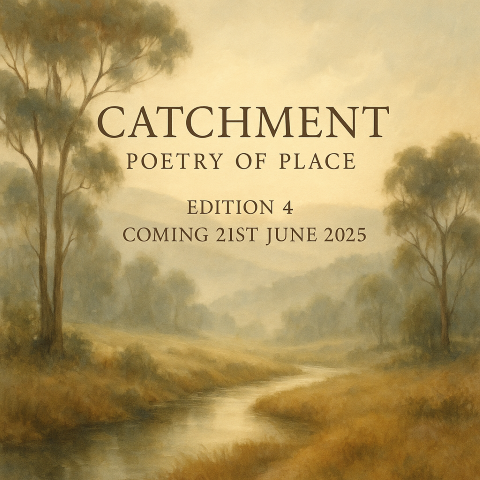Being released on this last day of submissions for Edition 4 of Catchment, you will find below the text of a poem written by a Melbourne-based writer named Helene Richards, who lives and works on the country of the Kulin nation.
You will also see that the response to Helene’s poem ‘Fog’ which follows here has been written by Peter Roberts.
A widely published writer, Peter has been – across the last two years – Poet-in-Residence for the Hobson’s Bay municipality, in Melbourne’s west.
Based there at the Louis Joel Arts & Community Centre, Peter produces – with his own team – a monthly podcast on poetry which can be accessed through such means as Spotify & Podbean.
Likewise an ongoing contributor to Catchment, Peter Roberts will collaborate in editing longer poetry for this upcoming fourth issue.
As a starting-point towards that new role, here is his appreciation of ‘Fog’ by Helene Richards, as a fine example of poetry of place:
Fog
It starts
with fine tendrils,
wispy scouts
for the main contingent
that slither in
on stealthy feet,
invading
the hills first,
then the trees
and houses,
hiding them behind
a thick, damp, grey curtain.
It plays tricks
on the senses,
deadening the sounds
of dogs barking,
of footsteps on pavements
and tyres
swishing on wet roads,
confusing distance,
concealing headlights
and other obstacles
until they are
almost upon you.
More slowly than usual
I walk to the train station,
not seeing
other travellers
but hearing
their muffled footsteps,
unable to guess
how close they are,
finding fences and potholes
in unexpected places,
enjoying the novelty
of this hushed muted world.
Helene Richards
Life Lines – Easy Poems for Busy People, HR Books, Melbourne, 2016
‘Alone in the misty landscape’: an evaluation of Helene Richards’ poem ‘Fog’
Helene Richards is an Australian poet who resides in Williamstown, on Port Phillip Bay, just to the south-west of central Melbourne.
Operating her own small press, with her writing recently short-listed for the City of Melbourne Lord Mayor’s Creative Writing Awards, she has been strongly involved in writing around Hobson’s Bay, in different capacities, for many years.
With Richards’ poem ‘Fog,’ the reader is immediately engaged by the first stanza, which pictures the fog in a military way, extending forward but preceded by ‘tendrils’ and ‘scouts’, like pathfinders ensuring that the territory is safe for the arrival of the ‘main contingent.’
What makes this so powerful is that this invading force obscures the landscape gradually, like the drawing of a ‘thick, damp, grey curtain.’
The poet does give hints of subterfuge, however, even menace, as this reconfiguration of the natural environment brings a new set of conditions that are described using expressions such as ‘slither in on stealthy feet’, ‘invading’ and ‘hiding.’
Thus, we get an unsettling juxtaposition between the beauty of the image and the potential for harmful or adverse outcomes.
The poet skilfully builds on the image of the partial curtain or wisps of fog to depict something that obscures all – first the trees, then the house.
Fog is a famous symbol in poetry and indeed many cultures.
In Norse mythology, for example, the fog had both practical and mythological aspects.
In the practical sense, it could – as Richards presents – be capable of disguising the landscape, yet for the Vikings that distortion could have been of strategic advantage, thus supporting an actual invasion or raid, with dire consequences for the local inhabitants.
Equally, it would provide a defensive shield, should there have been a need to retreat or change tactics.
At the other end of the spectrum is a notion, found in Hinduism, that the fog symbolises the illusion of the material world, which prevents one from seeing the true nature of reality.
For Helene Richards, the fog contains each element, but it also provides an environment whereby the poet can access a type of portal through which to escape the noise and reach of the world in a novel and enjoyable way.
In this sense we find a central movement within the poem, from an initial reaction of unease, even fear, to a growing comfort with the fog and what it allows the poet – and reader – to experience.
There are some echoes here of the work of the great American poet, Mary Oliver, who famously took long walks in nature and enjoyed the great variety of the natural world, along with its ability to present various features that Oliver found to be instructive in the cauldron of human affairs.
Like Oliver, Richards develops striking metaphors, such as ‘deadening the sounds of dogs barking, of footsteps on pavements.’
This example creates a strong aural image constructed with sparse language that allows the reader to absorb the poem without having to unpack a puzzle.
She goes further, however, picturing the fog as an identity, a personification, not just a meteorological phenomenon.
Together, these elements enable the poem to take on the features of reflection or meditation.
The second stanza moves from the descriptive to the interactive, as the poet begins to note her experience with the fog that ‘plays tricks/on the senses’, while ‘concealing headlights/ and other obstacles/ until they are/ almost upon you.’
Once again, the tone is one of trepidation, tinged with wonder that calls for adaptation and caution.
There are hints of the mystical, conveyed metaphorically, without specific comment from the poet.
As such it is one of many strengths of this poem: that is, its capacity to leave the reader alone in the misty landscape.
The third stanza is much more specific, located within the poet’s journey to the train station, presumably a trip taken regularly.
There are hazards but the overwhelming feeling is one of joy so powerfully captured in the concluding lines – ‘enjoying the novelty/ of this hushed muted world.’
We are now subsumed by the fog which has both figuratively and actually enveloped the poet.
It is a very beautiful ending, encouraging the reader to embrace change and to experience it as a kind of respite from the sights and sounds of our ordinary world, which can be intrusive.
The fog itself is ancient, and its presence can, as in Celtic mythology, create a kind of pause in time.
This can trigger revelation or just give the opportunity to sit briefly in the relative silence of the fog which obscures but does not erase that with which we are familiar.
For Richards, poetry seems to be about enabling its readership to grasp a strong visual image, to absorb the poet’s own reactions and observations, and then to be left to ponder what this landscape evokes for its audience.
This is critical to the finest poetry – the capacity not to direct readers to a predetermined conclusion, but to allow them to interact with the piece and take from it what they may.
It is in this interaction – between reader and words – that poetry truly comes alive.
Helene Richards’ powerful voice, metaphorical architecture and relatively straightforward language all serve this purpose, combining to achieve what a truly compelling poem should.
Peter Roberts
Co-editor,
Longer poetry
Edition 4
Catchment – Poetry of Place
Poet-in-Residence
Louis Joel Arts & Community Centre
Hobson’s Bay

